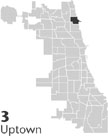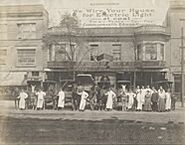| Entries |
| U |
|
Uptown
|
 Community Area 3, 6 miles N of the Loop. Only sparsely settled in the nineteenth century, Uptown has become one of the densest and most ethnically diverse residential areas of Chicago. In 1861
Graceland Cemetery
was opened in what is now the southwest quarter of Uptown, and soon became a destination for outings.
German
and
Swedish
immigrants operated scattered farms. The Cedar Lawn (1869), Buena Park (1860), Sheridan Park (1894), and
Edgewater
(1887) developments in
Lake View Township
brought middle-income and wealthy residents to the area. Land speculator John Lewis Cochran's (1857–1923) Edgewater set a building pattern for the area that fostered a broader mix of classes. Along the lakefront he favored mansions, but west of Evanston Avenue (Broadway) he encouraged multifamily housing. Cochran convinced the Chicago, Milwaukee & St. Paul
Railroad
to stop at Bryn Mawr Avenue and two decades later was instrumental in the building of the Northwestern Elevated Railroad Company tracks near his developments. These routes made Uptown one of Chicago's most populous residential centers.
Community Area 3, 6 miles N of the Loop. Only sparsely settled in the nineteenth century, Uptown has become one of the densest and most ethnically diverse residential areas of Chicago. In 1861
Graceland Cemetery
was opened in what is now the southwest quarter of Uptown, and soon became a destination for outings.
German
and
Swedish
immigrants operated scattered farms. The Cedar Lawn (1869), Buena Park (1860), Sheridan Park (1894), and
Edgewater
(1887) developments in
Lake View Township
brought middle-income and wealthy residents to the area. Land speculator John Lewis Cochran's (1857–1923) Edgewater set a building pattern for the area that fostered a broader mix of classes. Along the lakefront he favored mansions, but west of Evanston Avenue (Broadway) he encouraged multifamily housing. Cochran convinced the Chicago, Milwaukee & St. Paul
Railroad
to stop at Bryn Mawr Avenue and two decades later was instrumental in the building of the Northwestern Elevated Railroad Company tracks near his developments. These routes made Uptown one of Chicago's most populous residential centers.
A commercial boom in the first quarter of the twentieth century ushered in days of glamour. To compete with the Loop and Woodlawn, the Central Uptown Chicago Association promoted the area's shopping and recreational opportunities with images of New York City; the main thoroughfare became “Broadway” and the area, “Uptown.” Loren Miller's department store (later Goldblatt's) anchored the shopping district. Revelers visited the Aragon Ballroom (1926), the Riviera Theater (1919), the Uptown Theater (1925), and the Marine Room of the tony Edgewater Beach Hotel (1916). Thousands of worshipers flocked to the People's Church and tuned their radios to hear the sermons of Unitarian minister Preston Bradley. For a decade (1907–1917), Essanay Studios made Uptown the heart of the American film industry. Luxury apartment buildings and hotels appeared along Winthrop and Kenmore Avenues.

|
The changes in Uptown's economy, population, and housing stock drew the attention of residents, business owners, community organizers, and public officials. Longtime residents and commercial institutions created the Uptown Chicago Commission, which successfully sought designation as a conservation area (1966). The federal government made Uptown a Model Cities Area. New residents joined community organizations, including Jobs or Income Now, sponsored by Students for a Democratic Society; Slim Coleman's Heart of Uptown Coalition; and the Uptown Hull House's Organization of the Northeast. Wary of the land clearance that had accompanied urban renewal in Hyde Park and Lincoln Park, they wanted to improve local conditions while keeping Uptown within the means of the poor. They protested the building of Truman College (1976), which displaced several hundred residents.
Dozens of social service organizations opened to serve the needs of Uptown's diverse poor, including the American Indian Center, St. Augustine's Center for American Indians, the Lakefront SRO Corporation, a federal Urban Progress Center, and the Edgewater-Uptown Community Mental Health Center. Uptown continued to attract immigrants from Central America, Asia, Africa, and the Middle East into the twenty-first century.
Residents of Uptown who wished to distance themselves from its image of poverty and blight discovered a new way to protect their interests; they changed the public identification of their neighborhoods. Residents of the northern half of Uptown rediscovered the name “Edgewater” and in 1980 achieved recognition as a distinct community area, halving Uptown's population. Homeowners in Buena Park (the area between Graceland Cemetery and the lake) and Sheridan Park (between Graceland and St. Boniface Cemeteries), won recognition as historic landmark districts. The secession of these prosperous neighborhoods reinforced Uptown's reputation as an area of diversity amid faded glamour.
| Uptown (CA 3) | |||||
| Year |
Total
(and by category) |
Foreign Born | Native with foreign parentage | Males per 100 females | |
| 1930 | 67,699 | — | — | — | |
| 120,704 | White (178.3%) | ||||
| 531 | Negro (0.8%) | ||||
| 402 | Other (0.6%) | ||||
| 1960 | 76,103 | — | — | — | |
| 122,595 | White (161.1%) | ||||
| 423 | Negro (0.6%) | ||||
| 4,664 | Other races (6.1%) | ||||
| 1990 | 63,839 | 32.6% | — | 104 | |
| 30,113 | White (47.2%) | ||||
| 15,842 | Black (24.8%) | ||||
| 429 | American Indian (0.7%) | ||||
| 9,263 | Asian/Pacific Islander (14.5%) | ||||
| 8,192 | Other race (12.8%) | ||||
| 24,965 | Hispanic Origin* (39.1%) | ||||
| 2000 | 63,551 | 33.0% | — | 110 | |
| 32,750 | White alone (51.5%) | ||||
| 13,680 | Black or African American alone (21.5%) | ||||
| 383 | American Indian and Alaska Native alone (0.6%) | ||||
| 8,238 | Asian alone (13.0%) | ||||
| 102 | Native Hawaiian and Other Pacific Islander alone (0.2%) | ||||
| 5,567 | Some other race alone (8.8%) | ||||
| 2,831 | Two or more races (4.5%) | ||||
| 12,674 | Hispanic or Latino* (19.9%) | ||||
The Encyclopedia of Chicago © 2004 The Newberry Library. All Rights Reserved. Portions are copyrighted by other institutions and individuals. Additional information on copyright and permissions.